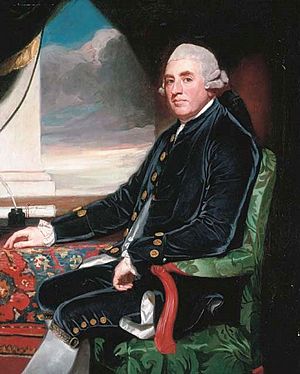Barry Maxwell, 1st Earl of Farnham facts for kids
Quick facts for kids
Barry Maxwell
|
|
|---|---|

portrait by George Romney
|
|
| 1st Earl of Farnham | |
| In office 1785–1800 |
|
| Member of the Irish Parliament for Cavan Borough |
|
| In office 1756–1760 |
|
| In office 1768–1779 |
|
| Member of the Irish Parliament for Armagh Borough |
|
| In office 1761–1768 |
|
| Personal details | |
| Born | 1723 |
| Died | 7 October 1800 |
| Spouses |
|
| Children | 5, including John James Maxwell, 2nd Earl of Farnham |
| Parents |
|
Barry Maxwell was an important Irish politician and nobleman who lived from 1723 to 1800. He became the 1st Earl of Farnham, a high title in Ireland. Before that, he was known as 'The Honourable Barry Maxwell'. He played a role in Irish politics during the 18th century.
Contents
Early Life and Family
Barry Maxwell was the son of John Maxwell, 1st Baron Farnham and Judith Barry. His family was well-known in Ireland.
Becoming a Lawyer
Barry Maxwell became a lawyer in 1748. He worked as a "Prothonotary" for the Court of Common Pleas from 1741 to 1800. This was a very important job, like being a chief clerk for the court. In 1757, he was made a "Bencher," which is a senior member of a law society.
Inheriting the Farnham Estate
In November 1779, Barry Maxwell's brother passed away. This meant Barry inherited the title of 3rd Baron Farnham. He also took over the large Farnham estate.
Building a New Home
After inheriting the estate, Barry Maxwell wanted a new house. He hired James Wyatt, a very famous architect of that time. Wyatt designed many beautiful buildings. The plans for Barry Maxwell's new house are now kept in a museum in New York City.
Political Achievements
Barry Maxwell held several important political titles during his life.
Rising Through the Ranks
On January 10, 1781, he was given the title of Viscount Farnham. A few years later, on June 22, 1785, he became the Earl of Farnham. These were high honors in the Irish peerage system. In 1796, he also became a Privy Councillor in Ireland. This meant he was a trusted advisor to the King or Queen.
Serving in Parliament
Barry Maxwell was a member of the Irish House of Commons, which was like the parliament for Ireland at the time.
- From 1756 to 1760, he represented Cavan Borough.
- He represented Cavan Borough again from 1768 to 1779.
- Between 1761 and 1768, he was the representative for Armagh Borough.
Family Life
Barry Maxwell was married twice and had several children.
First Marriage
In January 1757, he married Margaret King. She was the daughter of Robert King. They had three children together:
- John James Maxwell, 2nd Earl of Farnham (born 1760, died 1823). He later became the 2nd Earl of Farnham.
- Anne Maxwell, who married Richard Fox in 1787.
- Judith Maxwell, who never married and passed away in 1818.
Second Marriage
On August 5, 1771, Barry Maxwell married Grace Burdett. She was the daughter of Arthur Burdett. They had two daughters:
- Grace Maxwell (died 1866), who married Sir Ralph St George, 7th Baronet.
- Elizabeth Maxwell, who never married and passed away in 1782.
When Barry Maxwell passed away, his son John James inherited his titles and estate.

